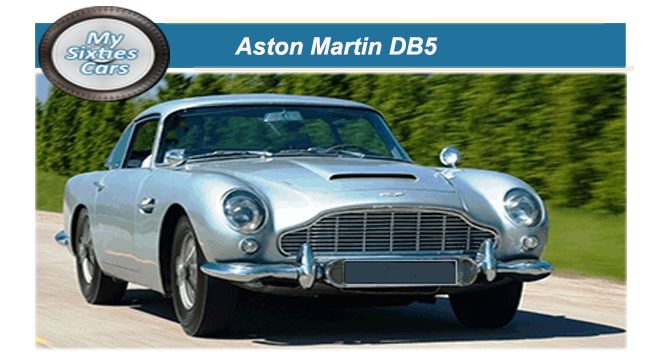
In 1963, Aston Martin eventually finished tweaking their DB4 Vantage, which had ostensibly evolved to become the DB5, a worthy follow-up to the DB4 that had seen the company carve out an unforgettable niche in the motoring history of the Sixties.
T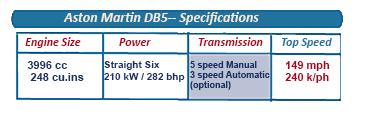 o auto purists, the DB5 was effectively a logical and worthy progression from its predecessor, going on to become a tremendous commercial success, selling in large numbers during its relatively short two-year production lifespan. This time around, the DB5 range of 4-liter six-cylinder engine machines, sports saloon and convertible were all released simultaneously.
o auto purists, the DB5 was effectively a logical and worthy progression from its predecessor, going on to become a tremendous commercial success, selling in large numbers during its relatively short two-year production lifespan. This time around, the DB5 range of 4-liter six-cylinder engine machines, sports saloon and convertible were all released simultaneously.
Almost identical to the Series Five DB4s, and running on the same 98in-wheelbase platform, the DB5 had a much larger engine, at 3995cccylinder providing 282bhp, although, for those with a need for speed, Aston Martin introduced the option of fitting a 325bhp engine a year after its launch.
In 1965, the DB5 convertible was updated and became the Volante; exceptionally stylish, open top motoring for the select few. From the production run of the DB4/5/6, convertibles only made up around one in every ten cars built.
Consequently, the value of these cars consistently far exceeds those of the coupe versions of the model
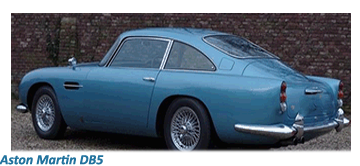 A choice of four or five-speed manual gearboxes were available for the DB5, with automatic transmission an optional extra. An alternator and twin-plate diaphragm spring clutch were fitted as standard.
A choice of four or five-speed manual gearboxes were available for the DB5, with automatic transmission an optional extra. An alternator and twin-plate diaphragm spring clutch were fitted as standard.
Overdrive was optional with the four-speed transmission, but only for three months, the five-speed ZF system and a single-plate clutch fitted as standard from 1964 onwards.
Among the refinements introduced for the DB5 were electric windows, faired-in headlamps, outstanding red rear lights on the door trailing edges, while Avon GT tyres were standard.
![]()
While the DB4 had been an imposing sporting machine, the DB5 was more refined, handling and performing just as well yet adding quietness and a smoothness which made it much more relaxing to drive.
Once again the joy of acquiring an Aston Martin was restricted to the rich and famous with a standard DB5 saloon costing £4,250 ($6400) and £4,635 ($7000) for the Convertible. A lot of money in the mid-Sixties.
A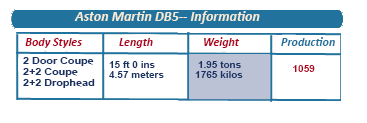 particularly handsome variant on the DB5 theme was the hardtop Convertible, outstanding with its exotically rakish lines, rounded off by a steeply raked wrap-around rear screen and really
particularly handsome variant on the DB5 theme was the hardtop Convertible, outstanding with its exotically rakish lines, rounded off by a steeply raked wrap-around rear screen and really
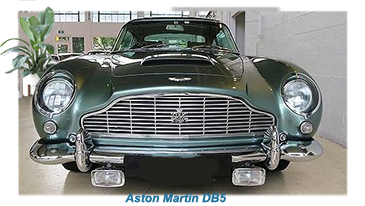 The new DB5 Vantage appeared in October 1964, following the removal of the automatic transmission option for the range in September.
The new DB5 Vantage appeared in October 1964, following the removal of the automatic transmission option for the range in September.
The Vantage's triple-Weber carburetter engine produced 314 bhp and with it a price tag of £4,600 ($6,900).
Modifications that followed in 1965 included Armstrong Selectaride shock absorbers being fitted as standard, while in August 1965 increases in demand prompted Aston Martin to resurrect their automatic transmission option after it had been prematurely discontinued.
A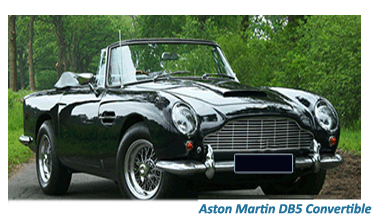 mong other mechanical innovations first aired on the DB5 were higher radial-pressure piston rings to ease oil consumption, changes to the distributor advance curve and the adoption of a 10-inch diaphragm clutch.
mong other mechanical innovations first aired on the DB5 were higher radial-pressure piston rings to ease oil consumption, changes to the distributor advance curve and the adoption of a 10-inch diaphragm clutch.
In August of 1965, Aston Martin announced that production of the DB5 production would be discontinued after just two years.
When production wound down a total of 1,150 units in all of the variations had been produced.
The decision to halt production of the DB5 came after Aston Martin moved to spacious premises at Newport Pagnell, amidst considerable preparations and investment to introduce the next in the series, the DB6.
![]()
Undoubtedly the most significant impression that the DB5 made in both motoring and movie history was being chosen by the producers of the James Bond films to use a specially adapted Silver Birch DB5 prototype in the Goldfinger and Thunderball classics.
Such exposure caused the DB5 to become amongst the most well known and desirable cars in the world, a status which remains to this day almost 50 years later.
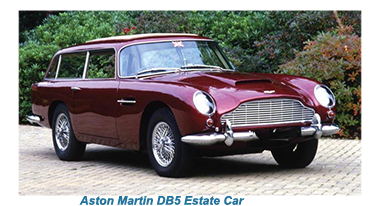 At the height of its success, Aston Martin found it impossible to keep pace with the phenomenal demand for the car fueled by the films.
At the height of its success, Aston Martin found it impossible to keep pace with the phenomenal demand for the car fueled by the films.
Even today, 007 and Aston Martin are inseparable. The Silver Birch DB5 has now appeared in a total of five Bond films, including the most recent, Skyfall.
Spin-offs from the DB5 included the Volante Drophead coupe launched in the autumn of 1965 to be updated just a year later to DB6 Volante status.
O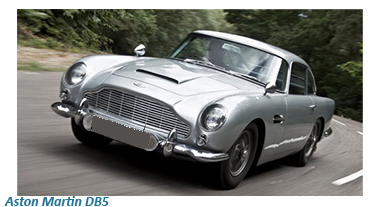 nly 65 DB5 Vantage coupés were built, while another variation on the theme the 1965 DB5 Vantage convertible sold 123 models, from 1963 through to 1965.
nly 65 DB5 Vantage coupés were built, while another variation on the theme the 1965 DB5 Vantage convertible sold 123 models, from 1963 through to 1965.
Originally only 19 of the 123 DB5 Convertibles made were left-hand drive, while 12 cars were initially fitted with a factory Vantage engine, and at least one further convertible was subsequently factory fitted with a DB6 specification Vantage engine.
The “ Short Volantes” differ from the DB5 convertible models as they feature DB6 split front and rear bumpers and rear TR4 lights, as also used on the DB6.
Another interesting spin-off was a DB5 shooting-brake around a prototype custom produced by the factory for the personal use of company owner David Brown.






